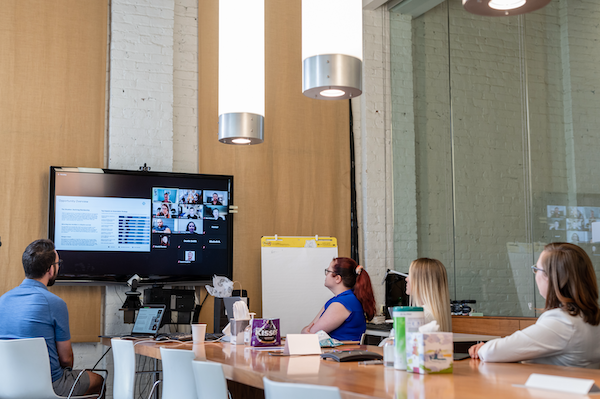
Let Meetings Breathe
Early in the pandemic, Charlie Rapple published a piece in the Scholarly Kitchen on “the doorway effect” - how the act of moving physically between meetings pre-pandemic allowed our brains to optimize memories and shed unneeded information. In the work-from-home era, these moments of transition are lost as back-to-back meetings dominate our days. In response to this phenomenon and in support of our commitment to organizing intentional and purposeful gatherings (our #1 Hybrid Workplace Norm), Silverchair is vigilant about the length of meetings.Engineer breaks between meetings. There is now strong evidence from brainwave studies that back-to-back meetings sap productivity by increasing stress and decreasing our ability to focus and engage. The simple remedy: short breaks. Silverchair actively encourages employees to allow breaks between all meetings by defaulting to our calendaring system to 5-minute breaks. Meetings that would have run by default for 30 minutes instead default to 25 minutes, and 60–minute meetings are automatically shortened to 55. As minor as it may seem, this scientifically-grounded change is helping us promote wellness and creativity.
Meetings should rarely run over (and, they ought to end early when possible). At Silverchair, we aim to keep meetings efficient. We start and end on time, and we do not use all of the time we have calendared if we can help it. It is commonplace for meeting facilitators to either end meetings early, or at least express a desire to do so. This is a sign of respect for ourselves and our colleagues, and a continual affirmation of the importance we place on protecting time for reflection, which leads to greater clarity and quality of thought.
Schedule (and respect) time to think. It has become normative at Silverchair for people to protect blocks of calendar time for thinking and reflection (variously referred to as “flow time” or “focus time”). This has been facilitated by the fact that some of our executive team members have embraced and thereby destigmatized this habit. When we see a block of time reserved for thinking on the calendar of a colleague, we treat it just as we would a meeting, and we do not propose a meeting during that time without asking first for permission.
Make Communication Channels and Expectations Explicit
Establish meeting design principles. Not only must we be mindful of the length and density of meetings, but we should also question whether a meeting is needed at all. For time when a meeting is necessary, Silverchair has established guidelines on how to effectively plan and execute meetings based upon their purpose - selecting the right modality (e.g., online with/without video), location (collocated, remote, or hybrid), and agenda design. We have also provided company-wide training on how to run effective hybrid meetings.Promote the timely sharing of information with those who need it. It is by now well understood that remote workers can be limited in their ability to succeed by the fact that they are excluded from the casual sense-making conversations that occur in a collocated space. Silverchair has therefore established norms about when information needs to be conveyed to those who are not there to hear it and when a discussion needs to be paused so others are included. Concurrently, we have also mapped Silverchair’s diverse communication channels and published, including our meeting types, and published guidelines for facilitators and participants to ensure messages are amplified when and as they should.
Document Unspoken Cultural Norms
Like every organization, Silverchair has had unspoken cultural norms that define who we are and what it means to work here. This is different from our core values, which are displayed across our building and spoken of with reverence. Cultural norms are the unwritten ways of being that our people picked up in the before through observation and intuition simply by immersing themselves in our collocated environment. Our cultural norms are how we actually live out our core values – and we are finding that these norms are not always self-evident to new members of our community who have joined us since we became a remote-first hybrid organization.We are in the process of canonizing these unspoken cultural norms including an introduction to those norms as a critical piece of the onboarding process for new Silverchairians. Some of the cultural norms our teams have validated are:
- Questioning is welcome. When we say speak your mind, we mean that it's okay to ask questions of anyone at any time, regardless of role or seniority.
- Feedback is a way of life. You can and should give feedback to anyone who works here, as long as you do so constructively and respectfully.
- Authenticity is our currency. As long as you show up with authenticity, we will accept you for who you authentically are.
- We respect your autonomy. We respect you as an adult, which means we will not tell you what to do. We trust you to make good decisions with the information you have.
- We are committed to wellbeing. Caring for your own wellbeing is a form of community care. If you're sick, take a sick day so you can return refreshed. If you're feeling burned out, schedule PTO.
- We get better together. Do not let the quest for individual perfection become the enemy of team success. It is better to err on the side of imperfection and share work early so that your colleagues have an opportunity to offer upgrades.
Read more about Silverchair’s workplace of the future on the Scholarly Kitchen.